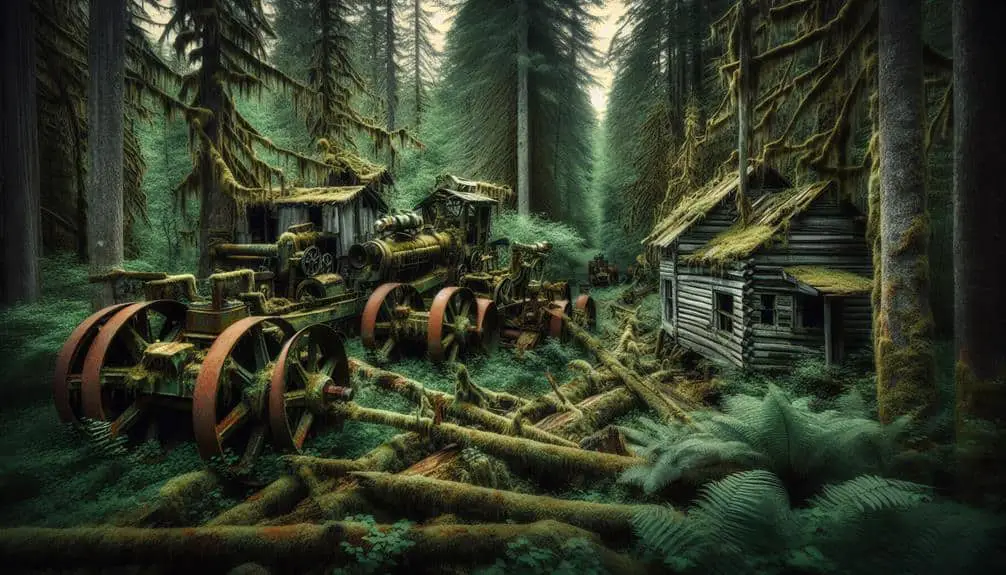Explore the haunting remnants of abandoned logging camps, where echoes of past industry linger amidst decayed structures and rusted machinery. Dilapidated bunkhouses, collapsed mess halls, and rusted sawmills are common sights. Nature reclaims these sites, with vegetation breaking through concrete foundations. Preservation efforts aim to safeguard this historical heritage and revitalize local economies.
Key Points
- Dilapidated bunkhouses and collapsed mess halls show structural decay.
- Rusted skeletons of logging equipment like sawmills and pulleys are common.
- Nature's reclamation process transforms camps into serene landscapes.
- Remnants include weathered details of craftsmanship and old machinery.
- Walls with signs of decay, collapsed roofs, and rotting beams tell stories of past activities.
Historical Origins of Logging Camps
The historical origins of logging camps can be traced back to the 19th century when the demand for timber surged with the expansion of industries and infrastructure. As industries grew, the need for vast amounts of timber rose exponentially, leading to the establishment of logging camps in remote areas close to forests. These camps served as temporary homes for loggers and provided the necessary infrastructure for timber extraction.
The development of logging camps was closely tied to the industrial revolution, marking a significant shift in how natural resources were exploited. The legacy of these camps can still be seen today in the form of abandoned structures and old logging equipment scattered throughout wooded areas. Their impact on the environment is evident in the scars left behind by clear-cutting and deforestation, highlighting the consequences of unchecked resource extraction.
Architecture and Structures Left Behind
Scattered amidst the wilderness are the remnants of architecture and structures left behind by the abandoned logging camps. As you explore these areas, you'll come across fascinating architectural ruins that stand as a proof to the once-thriving camps. The structural decay evident in these buildings tells a story of neglect and the passage of time.
The architectural ruins vary in size and purpose, ranging from dilapidated bunkhouses to collapsed mess halls. You may notice the intricate details of the construction, now weathered and worn, hinting at the craftsmanship of the past. The walls, once sturdy and protective, now show signs of structural decay, with roofs caving in and wooden beams succumbing to rot.
Each building whispers a tale of the bustling activity that once filled the camp, now reduced to a silent echo in the wilderness. As you examine these architectural remnants, take a moment to appreciate the history they hold and the stories they silently reveal about the lives of those who worked and lived in these remote logging camps.
Logging Equipment and Machinery Ruins
Among the remnants of abandoned logging camps lie the rusted skeletons of logging equipment and machinery, silent witnesses to a bygone era of industry and toil. These rusty relics, overgrown by nature's reclamation, stand as monuments to the once-thriving logging operations that echoed through the forests.
Forgotten machines, decaying under the weight of time, paint a picture of the challenging conditions loggers faced daily. The skeletal frames of old sawmills, the rusted gears of pulleys and winches, and the shattered remains of conveyor belts speak of a time when these tools were the heartbeat of the camp. Each piece tells a story of hard work, sweat, and the rugged determination of those who operated them.
Surrounded by encroaching vegetation and weathered by the elements, these remnants remind us of the transient nature of industry and the inevitable march of time. As you walk among these relics, you can almost hear the echoes of machinery and the shouts of workers, now mere whispers in the wind.
Natures Reclamation of Camp Sites
Amidst the abandoned logging camps, nature's essential reclamation process unfolds, transforming once bustling sites into serene landscapes over time. The ecosystem gradually regains its balance as flora and fauna reclaim the spaces once dominated by human activity. Initially, pioneer plant species such as mosses and lichens take hold on the barren grounds, preparing the soil for more complex vegetation to follow. Over time, shrubs and trees begin to take root, their roots breaking through concrete foundations and asphalt roads, symbolizing nature's resilience.
Fauna also play an important role in the regeneration of these abandoned sites. Birds nest in the rafters of old buildings, small mammals make homes in the decaying structures, and insects thrive in the undisturbed corners. These organisms contribute to the breakdown of man-made materials, aiding in the gradual return of these areas to a more natural state.
In this process of reclamation, the once disrupted balance is restored, showcasing the remarkable ability of nature to heal and regenerate even in the face of human intervention.
Preservation Efforts for Logging Camps
Efforts to preserve the historical integrity of abandoned logging camps are crucial in maintaining a tangible link to our past industrial heritage. These camps hold significant cultural value as they provide insight into the lives of loggers and the impact of the logging industry on local communities. Preservation initiatives aim to safeguard the remaining structures, artifacts, and landscapes associated with these camps, guaranteeing that future generations can learn from and appreciate this important aspect of history.
In addition to their cultural significance, the restoration of logging camps can have a positive economic impact on surrounding areas. By creating heritage sites or tourist attractions, abandoned logging camps can contribute to local economies through increased tourism, job opportunities, and revenue generation. Furthermore, restoring these camps can revitalize communities by highlighting their unique histories and attracting visitors interested in experiencing the heritage and stories of the logging industry firsthand. Through preservation efforts and restoration projects, we can make sure that the legacy of these logging camps continues to be remembered and appreciated for years to come.
Frequently Asked Questions
What Were the Living Conditions Like for the Workers in These Abandoned Logging Camps?
Living conditions in abandoned logging camps were harsh. Workers faced cramped quarters, limited sanitation, and safety hazards. The remote locations meant help was far away. Safety regulations were often ignored, risking worker well-being for profit.
Are There Any Ghost Stories or Legends Surrounding These Abandoned Logging Camps?
When exploring abandoned logging camps, you might hear haunting folklore and tales of supernatural encounters. Paranormal investigations have been conducted, and mysterious disappearances have added to the eerie reputation. These sites are rich in ghost stories.
How Did the Closure of These Logging Camps Impact the Surrounding Communities?
The closure of logging camps had far-reaching effects on surrounding communities. Economic impact was severe, leading to job loss and financial strain. Community relationships suffered, social dynamics shifted, and cultural changes were inevitable as the camps shut down.
Have Any Artifacts or Personal Belongings Been Found at These Abandoned Logging Camps?
You may be surprised by the number of artifacts discovered at abandoned logging camps. Personal belongings found offer a glimpse into the lives of those who once worked there, preserving history amidst nature's reclamation.
Are There Any Environmental Concerns or Hazards Associated With These Abandoned Logging Camps?
When exploring abandoned logging camps, you'll encounter environmental impacts like soil erosion, water contamination, and habitat disruption. Hazards such as decaying structures and leftover chemicals pose risks. Preservation and restoration efforts aim to mitigate these concerns for a healthier ecosystem.



